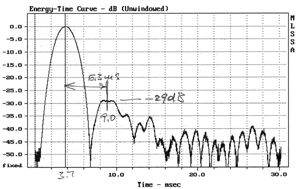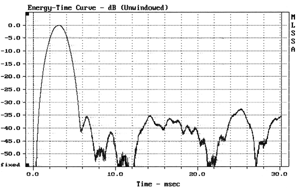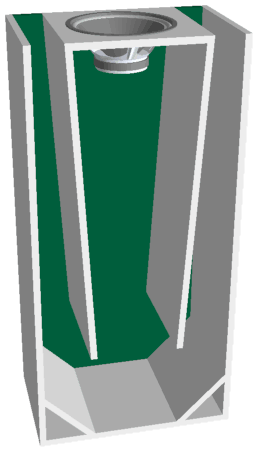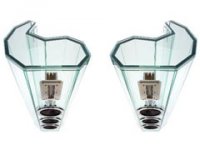Hola Terry
I don't think the length and exact details of the 'tube' will be all that important. Just get the rear wave away from the driver into a well stuffed enclosure and if the path is a bit convoluted, all the better.
For a suggestion on how you could do it, check out this, but I think you may have seen it already on the SNA thread.
Jiri's PHL/RAAL design
The shredded jeans mentioned earlier is just cotton waste, same as used in machine shops to clean up with. Works well and cheap too.
I don't think the length and exact details of the 'tube' will be all that important. Just get the rear wave away from the driver into a well stuffed enclosure and if the path is a bit convoluted, all the better.
For a suggestion on how you could do it, check out this, but I think you may have seen it already on the SNA thread.
Jiri's PHL/RAAL design
I don't know why either.terry j said:
Again, really, why does all the stuffing usually get put directly on the box wall??
The shredded jeans mentioned earlier is just cotton waste, same as used in machine shops to clean up with. Works well and cheap too.
thanks Brett, but I think that one might be a tad overkill!!
the limiting factor in all of this is simply volume. I am completely set on my boxes now, just spent y/day afternoon turning up my speaker spikes (using 16 mm threaded rod as the spikes), so can now do the wrap.
The saving grace is I only need ten l maximum for the mid chamber, any more eats away at my already tight bass driver volume. Jiris is way too big, tho it is d'apploito from memory. But I would guess his is a TL for the main TL reason ie bass and bass extension?
That aspect is not needed in my case.
When I do go ahead with the side by side comparison, I could either bring them down to your place and we can do some listening together (another set of ears would be great) or you can reward yourself an exam holiday and come on out.
Or not of course.
I take great pleasure in 'testing theories'. (too much audio is just keyboard discussions, like some 100+ page threads around here??)
it has completely slipped my mind since lindy came home, but I assume the goods were exchanged ok?
the limiting factor in all of this is simply volume. I am completely set on my boxes now, just spent y/day afternoon turning up my speaker spikes (using 16 mm threaded rod as the spikes), so can now do the wrap.
The saving grace is I only need ten l maximum for the mid chamber, any more eats away at my already tight bass driver volume. Jiris is way too big, tho it is d'apploito from memory. But I would guess his is a TL for the main TL reason ie bass and bass extension?
That aspect is not needed in my case.
When I do go ahead with the side by side comparison, I could either bring them down to your place and we can do some listening together (another set of ears would be great) or you can reward yourself an exam holiday and come on out.
Or not of course.
I take great pleasure in 'testing theories'. (too much audio is just keyboard discussions, like some 100+ page threads around here??)
it has completely slipped my mind since lindy came home, but I assume the goods were exchanged ok?
Terry, not sure how your space is arranged inside the box, but a simple W shape has worked well in the past; rear wave goes to back wall with reflectors to have it come to the front of the enclosure on both sides with as much space/length/taper as you can manage. The first part of Jiri's is close; depending on space and layout you could have it symmetrical around the driver.
If none of the above was clear, I'll sketch up something and post it later if you'd like. I'm going to be using the same basic thing in the side and rear surrounds.
Sure, I'd love to catch up and hear them and help if I can. I move in about 5 weeks so my place is chaos, but a daytrip would be cool up to Casa Jones. I want to see the vinyl application too as I snaffled some Tannoy drivers and want to use it for some bedroom speakers.
If none of the above was clear, I'll sketch up something and post it later if you'd like. I'm going to be using the same basic thing in the side and rear surrounds.
Sure, I'd love to catch up and hear them and help if I can. I move in about 5 weeks so my place is chaos, but a daytrip would be cool up to Casa Jones. I want to see the vinyl application too as I snaffled some Tannoy drivers and want to use it for some bedroom speakers.
SL did a "backwave control" work in his Pluto. He argues (and measured) that the backwave can be minimised using enclosed pipe with sufficient length and damping.
http://linkwitzlab.com/Pluto/construction.htm
The reflection is -40db which is excellent, but when I built my Pluto clone, they are definitely still gives some signature to the sound. Noticable when I go back and forth to OB and longer listening.
Note that Pluto's pipe length is very long compared to typical box speaker depth.
Without damping

With damping

http://linkwitzlab.com/Pluto/construction.htm
The reflection is -40db which is excellent, but when I built my Pluto clone, they are definitely still gives some signature to the sound. Noticable when I go back and forth to OB and longer listening.
Note that Pluto's pipe length is very long compared to typical box speaker depth.
Without damping

With damping

Brett if it's easy, a quick sketch would be great (gotta know what to build)
understand about the w shape, but that is two dimensional, would we get any improvements if it was 'rotated' about a central axis, ie 'three' dimensional?
TBH it would be easier done here, can use the deqx and only listen to the mids playing their bandpass frequencies.
gainphile, would we seriously consider a tube for a mid chamber? he used a tube for the pluto as it does so many different things to what is needed here, would he have gotten better suppression if was designed to reflect to a 'black hole of nothingness'?
Maybe I am getting hung up on complexities. Can we make an assumption that soundwaves reflect as lightwaves, ie angle of incidence etc etc. If so, there must be plenty of standard mathematical curves that provide that type of reflection, just don't know what term to type in to find them!
understand about the w shape, but that is two dimensional, would we get any improvements if it was 'rotated' about a central axis, ie 'three' dimensional?
TBH it would be easier done here, can use the deqx and only listen to the mids playing their bandpass frequencies.
gainphile, would we seriously consider a tube for a mid chamber? he used a tube for the pluto as it does so many different things to what is needed here, would he have gotten better suppression if was designed to reflect to a 'black hole of nothingness'?
Maybe I am getting hung up on complexities. Can we make an assumption that soundwaves reflect as lightwaves, ie angle of incidence etc etc. If so, there must be plenty of standard mathematical curves that provide that type of reflection, just don't know what term to type in to find them!
Brett said:the length and exact details of the 'tube' will be all that important. Just get the rear wave away from the driver into a well stuffed enclosure and if the path is a bit convoluted, all the better.
That is the recipe... it is aperiodic in the end, as long as it is big enuff the other detail is minor. A heavy taper lets you get away with a smaller box. If you can make it a straight shot out the back you'll have fewer reflections... in a retrofit, i'll often just use a chunk of PVC out the back (if you are shy on cabinet volume it could just stick out of the box (with the obvious aesthetic caveats)
Here is an example of a W (just shrink to size for a midrange)

If you really want to test your cab building skills you could make the 1st section a pyramid and have 4 termini on each side of the driver.
dave
I think I can work with something like that dave, thanks. going the four terminae (?) is what I was wondering about.
a few confusions still, I always thought aperiodic was to do with 'venting' to the atmosphere, but I can simply seal it off yeah?
The enclosed volume remains the same, ie say ten l in my case?
edit. back to one of my earlier questions, I see that it is built of hard material like mdf. If I were to substitute rigid f/glass, would that increase the absorption?, or is the hard surface somehow needed for the reflection.
a few confusions still, I always thought aperiodic was to do with 'venting' to the atmosphere, but I can simply seal it off yeah?
The enclosed volume remains the same, ie say ten l in my case?
edit. back to one of my earlier questions, I see that it is built of hard material like mdf. If I were to substitute rigid f/glass, would that increase the absorption?, or is the hard surface somehow needed for the reflection.
Hi terry check out Crystal cables speaker cab
http://www.crystalcable.com/index.php?page=cid334
Cheers
http://www.crystalcable.com/index.php?page=cid334
Cheers
Attachments
terry j said:a few confusions still, I always thought aperiodic was to do with 'venting' to the atmosphere, but I can simply seal it off yeah?
Yes. That's the way i do it.
The enclosed volume remains the same, ie say ten l in my case?
i can't say for sure, the sealed varianr might well need to be bigger (it should be fairly low Q)
I see that it is built of hard material like mdf. If I were to substitute rigid f/glass, would that increase the absorption?, or is the hard surface somehow needed for the reflection.
What is the it that you refer to?
dave
the 'it'.
simply the pyramid, the w, the reflecting walls.
for ease of description, let's say we simply build a reducing cone as the enclosure.
I can make it out of a hard substance like mdf, or out of rigid f/glass.
As the purpose is to absorb it, and reflect the wave further into the 'black hole of nothingness', would not the f/glass absorb it better than mdf, and any that is not absorbed still gets reflected further into the cone, where if made of f/glass has even more chance of being absorbed.
Ie, two built exactly to your plan there, one out of mdf and one out of rigid f/glass.
which would do the best job of reducing the backwave coming back thru the driver diaphragm
simply the pyramid, the w, the reflecting walls.
for ease of description, let's say we simply build a reducing cone as the enclosure.
I can make it out of a hard substance like mdf, or out of rigid f/glass.
As the purpose is to absorb it, and reflect the wave further into the 'black hole of nothingness', would not the f/glass absorb it better than mdf, and any that is not absorbed still gets reflected further into the cone, where if made of f/glass has even more chance of being absorbed.
Ie, two built exactly to your plan there, one out of mdf and one out of rigid f/glass.
which would do the best job of reducing the backwave coming back thru the driver diaphragm
terry j said:simply the pyramid, the w, the reflecting walls.
Since the point of thedm is to make a transmission line they need to be solid. It is the length of the TL that gets you the ability to absorb to a lower frequency (i'd never use MDF thou -- not a good material for building cabinets out of)
dave
Terry, Dave's pic is similar to what I would have drawn, with the addition of a wedge on the wall directly behind the driver to act as a reflector into the curves.
If you meant resin and fibreglass as a wall material, that would be fine as will MDF in this application. I'd also seal the holes at the end on the baffle.
Although you only need 10L of internal volume, more shouldn't be an issue. It will just make the Qt a bit low, but you're no doubt going to EQ to taste anyway.
If you meant resin and fibreglass as a wall material, that would be fine as will MDF in this application. I'd also seal the holes at the end on the baffle.
Although you only need 10L of internal volume, more shouldn't be an issue. It will just make the Qt a bit low, but you're no doubt going to EQ to taste anyway.
Jeroen's design (the "ultimate monitor" link from the 1st post) is based on what is in the B&W whitepaper on the Nautilus, the combination of the ball and the inverted horn is what makes this work.
here
http://picasaweb.google.com/collier6/Concave?feat=directlink#
is another project that might inspire you...
here
http://picasaweb.google.com/collier6/Concave?feat=directlink#
is another project that might inspire you...
your build?
very well documented, and a LOT of effort put into it!
am a bit confused tho, ahh not on a closer look. I saw what I thought were two PRs, but obviously not two in one box. The mid has it's own cab (I did note the shape, thanks) and one woofer has it's own box too, and the bottom has a woofer and PR.
Attention to detail all right, loved the crossover.
guess if you have a cad router, you may as well use it right?
Me?? Think I'll just measure my speakers in the room, how the heck did they manage to get it up there?
thanks, an enjoyable show.
very well documented, and a LOT of effort put into it!
am a bit confused tho, ahh not on a closer look. I saw what I thought were two PRs, but obviously not two in one box. The mid has it's own cab (I did note the shape, thanks) and one woofer has it's own box too, and the bottom has a woofer and PR.
Attention to detail all right, loved the crossover.
guess if you have a cad router, you may as well use it right?
Me?? Think I'll just measure my speakers in the room, how the heck did they manage to get it up there?
thanks, an enjoyable show.
no.. a friendterry j said:your build?
yes, he has a CNC router... he paid special attention to the bass as well, since his demands here were very high (he's a bass player and bassguitar builder as well). the shape of the mid cab was optimised to get the waterfall as clean as possible with a minimum of stuffing. iirc a open ended TL was also in one of the prototypes
What about filling the space with drinking straws (or similar)?
First of all, this should be very linear, as you can pack them in firmly, so they won't move at high amplitudes (unlike loose fluffy materials).
They constrain the air flow to be in a specified direction, so lateral and hybrid modes disappear.
The flow resistance is easy to work out (Poiseuille's law), and can be arranged to give significant absorption of the back wave; this means narrower, longer straws give more damping. Flow resistance of each straw goes like R^4; the total resistance of densely packed straws in a given area goes like R^2, assuming the wall is thin, as you can pack more thin straws into a given area.
The flow pattern will remain laminar even at much higher flow velocities than will occur, so again linearity should be near perfect - weird stuff happens when the flow velocity is over about mach 0.3, but loudspeakers are miles away from that; full power in the midrange corresponds to gas velocities of a few metres/s at most.
See http://en.wikipedia.org/wiki/Poiseuille's_law
First of all, this should be very linear, as you can pack them in firmly, so they won't move at high amplitudes (unlike loose fluffy materials).
They constrain the air flow to be in a specified direction, so lateral and hybrid modes disappear.
The flow resistance is easy to work out (Poiseuille's law), and can be arranged to give significant absorption of the back wave; this means narrower, longer straws give more damping. Flow resistance of each straw goes like R^4; the total resistance of densely packed straws in a given area goes like R^2, assuming the wall is thin, as you can pack more thin straws into a given area.
The flow pattern will remain laminar even at much higher flow velocities than will occur, so again linearity should be near perfect - weird stuff happens when the flow velocity is over about mach 0.3, but loudspeakers are miles away from that; full power in the midrange corresponds to gas velocities of a few metres/s at most.
See http://en.wikipedia.org/wiki/Poiseuille's_law
Wow. Excellent build.Henkjan said:Jeroen's design (the "ultimate monitor" link from the 1st post) is based on what is in the B&W whitepaper on the Nautilus, the combination of the ball and the inverted horn is what makes this work.
here
http://picasaweb.google.com/collier6/Concave?feat=directlink#
is another project that might inspire you...
Piglet, I like the drinking straws idea. At the very least it's a cheap experiment.
terry j said:your build?
Henkjan said:no.. a friend
Thanks HenkJan, I'm flattered being called 'a friend'!
The Concave concept was inspired by the Sphere Horn which was a project from one of the Dutch DIY Audio Forum members. See the link that the TS posted in his first mail.
That project was a result of B&W's white papers on the Sphere Horn.
Taking this theory in my own project brought me to the Concave mid enclosure. This enclosure is a combination of the Phere Horn, an infinite Transmission line and what I call, projection technology.
Ed.
Brett said:I like the drinking straws idea. At the very least it's a cheap experiment.
(i'm assumming you are talking about drinking straws in the port as i didn't see any drinking straws in that photo gallery)
Brett, I'm surprised you haven't run into that before, the idea has been around for a long time. Mission even did an injection moulded port that commercialized the idea. This is one of the concepts that aided in coming up with the porting on the Fonkens (which was a huge success)
dave
- Status
- Not open for further replies.
- Home
- Loudspeakers
- Multi-Way
- 'exotic' techniques for absorbing the mid backwave (and bass)
